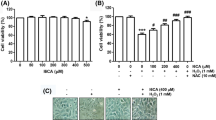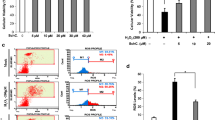Abstract
Background
HS1793, a novel analogue of resveratrol, was previously determined to be more potent at lower dosages by improving mitochondrial function and increased mitochondrial biogenesis-related proteins. In this study, we focused on targeting the mitochondria to address muscle wasting with HS-1793.
Method
Dosage screening was performed by evaluating for cytotoxicity and cell proliferation. Mitochondrial mass, mitochondrial membrane potential (Δψm), reactive oxygen species (ROS) level, and mitochondria biogenesis-regulated genes and proteins were analyzed to determine the effects on mitochondrial biogenesis.
Results
HS-1793 reduced ROS generation, but treatment did not interfere with cellular viability at low dosages. HS-1793 also regulated mitochondrial function by increasing cellular and mitochondrial ATP synthesis function, stabilizing Δψm and decreasing ROS. More importantly, these dysfunction in these parameters were ameliorated by HS-1793 in a simulated oxidative stress model with tBHP. We also observed increase in mitochondrial mass and upregulation in vital mitochondrial biogenesis-related gene PGC1-α as a response to HS-1793 treatment. Moreover, phosphorylation of AKT and mTOR proteins, which are considered as regulators of skeletal muscle function were also increased during the treatment. Finally, HS-1793 also demonstrated protective effects against cisplatin-induced skeletal muscle cell injury by increasing expression of mitochondrial biogenesis-relate markers.
Conclusion
Taken altogether, it shows the viability of HS-1793 as a compound that can restore mitochondrial function and render protection in skeletal muscle cells, especially during high oxidative stress levels.





Similar content being viewed by others
References
Abrigo J, Simon F, Cabrera D, Vilos C, Cabello-Verrugio C (2019) Mitochondrial dysfunction in skeletal muscle pathologies. Curr Protein Pept Sci 20:536–546. https://doi.org/10.2174/1389203720666190402100902
Alway SE et al (2017) Resveratrol enhances exercise-induced cellular and functional adaptations of skeletal muscle in older men and women. J Gerontol A Biol Sci Med Sci 72:1595–1606. https://doi.org/10.1093/gerona/glx089
Ballinger SW (2005) Mitochondrial dysfunction in cardiovascular disease. Free Radic Biol Med 38:1278–1295. https://doi.org/10.1016/j.freeradbiomed.2005.02.014
Bodine SC et al (2001) Akt/mTOR pathway is a crucial regulator of skeletal muscle hypertrophy and can prevent muscle atrophy in vivo. Nat Cell Biol 3:1014–1019. https://doi.org/10.1038/ncb1101-1014
Cecchinato V et al (2007) Resveratrol-induced apoptosis in human T-cell acute lymphoblastic leukaemia MOLT-4 cells. Biochem Pharmacol 74:1568–1574. https://doi.org/10.1016/j.bcp.2007.08.001
Chauhan M, Punga T, Punga AR (2013) Muscle-specific regulation of the mTOR signaling pathway in MuSK antibody seropositive (MuSK+) experimental autoimmune Myasthenia gravis (EAMG). Neurosci Res 77:102–109. https://doi.org/10.1016/j.neures.2013.07.008
Coletti D (2018) Chemotherapy-induced muscle wasting: an update. Eur J Transl Myol 28:7587. https://doi.org/10.4081/ejtm.2018.7587
Egerman MA, Glass DJ (2014) Signaling pathways controlling skeletal muscle mass. Crit Rev Biochem Mol Biol 49:59–68. https://doi.org/10.3109/10409238.2013.857291
Fernandez-Marcos PJ, Auwerx J (2011) Regulation of PGC-1alpha, a nodal regulator of mitochondrial biogenesis. Am J Clin Nutr 93:884S–890. https://doi.org/10.3945/ajcn.110.001917
Irrcher I, Ljubicic V, Hood DA (2009) Interactions between ROS and AMP kinase activity in the regulation of PGC-1alpha transcription in skeletal muscle cells. Am J Physiol Cell Physiol 296:C116–123. https://doi.org/10.1152/ajpcell.00267.2007
Jasinski M, Jasinska L, Ogrodowczyk M (2013) Resveratrol in prostate diseases—a short review. Cent Eur J Urol 66:144–149. https://doi.org/10.5173/ceju.2013.02.art8
Jeong SH et al (2012) An analogue of resveratrol HS-1793 exhibits anticancer activity against MCF-7 cells via inhibition of mitochondrial biogenesis gene expression. Mol Cells 34:357–365. https://doi.org/10.1007/s10059-012-0081-7
Jeong SH et al (2013) HS-1793, a recently developed resveratrol analogue protects rat heart against hypoxia/reoxygenation injury via attenuating mitochondrial damage. Bioorg Med Chem Lett 23:4225–4229. https://doi.org/10.1016/j.bmcl.2013.05.010
Jeong MH et al (2014a) In vitro genotoxicity assessment of a novel resveratrol analogue, HS-1793. Toxicol Res 30:211–220. https://doi.org/10.5487/TR.2014.30.3.211
Jeong MH et al (2014b) Protective activity of a novel resveratrol analogue, HS-1793, against DNA damage in 137Cs-irradiated CHO-K1 cells. J Radiat Res (Tokyo) 55:464–475. https://doi.org/10.1093/jrr/rrt140
Josiak K, Jankowska EA, Piepoli MF, Banasiak W, Ponikowski P (2014) Skeletal myopathy in patients with chronic heart failure: significance of anabolic-androgenic hormones. J Cachexia Arcopenia Muscle 5:287–296. https://doi.org/10.1007/s13539-014-0152-z
Kim HJ et al (2012) The novel resveratrol analogue HS-1793 induces apoptosis via the mitochondrial pathway in murine breast cancer cells. Int J Oncol 41:1628–1634. https://doi.org/10.3892/ijo.2012.1615
Kim JA et al (2014) HS-1793, a resveratrol analogue, induces cell cycle arrest and apoptotic cell death in human breast cancer cells. Int J Oncol 44:473–480. https://doi.org/10.3892/ijo.2013.2207
Lai KM et al (2004) Conditional activation of akt in adult skeletal muscle induces rapid hypertrophy. Mol Cell Biol 24:9295–9304. https://doi.org/10.1128/MCB.24.21.9295-9304.2004
Ogasawara R et al (2016) The role of mTOR signalling in the regulation of skeletal muscle mass in a rodent model of resistance exercise. Sci Rep 6:31142. https://doi.org/10.1038/srep31142
Raj P et al (2014) Potential of resveratrol in the treatment of heart failure. Life Sci 95:63–71. https://doi.org/10.1016/j.lfs.2013.12.011
Reynolds THT, Bodine SC, Lawrence JC Jr (2002) Control of Ser2448 phosphorylation in the mammalian target of rapamycin by insulin and skeletal muscle load. J Biol Chem 277:17657–17662. https://doi.org/10.1074/jbc.M201142200
Um HJ et al (2010) Differential effects of resveratrol and novel resveratrol derivative, HS-1793, on endoplasmic reticulum stress-mediated apoptosis and Akt inactivation. Int J Oncol 36:1007–1013. https://doi.org/10.3892/ijo_00000581
Wang X, Proud CG (2006) The mTOR pathway in the control of protein synthesis. Physiology 21:362–369. https://doi.org/10.1152/physiol.00024.2006
Acknowledgements
This work was supported by the Ministry of Education of Korea (2010-0020224), and by the Korea Government Ministry of Science and ICT (2018R1A2A3074998).
Author information
Authors and Affiliations
Corresponding author
Ethics declarations
Conflict of interest
The authors declare that they have no conflict of interest.
Human and animal rights
The article does not contain any studies with human and animal and this study was performed following institutional and national guidelines.
Additional information
Publisher's Note
Springer Nature remains neutral with regard to jurisdictional claims in published maps and institutional affiliations.
Rights and permissions
About this article
Cite this article
Marquez, J., Park, N., Garcia, M.V.F. et al. HS-1793 protects C2C12 cells from oxidative stress via mitochondrial function regulation. Mol. Cell. Toxicol. 16, 359–365 (2020). https://doi.org/10.1007/s13273-020-00090-w
Received:
Accepted:
Published:
Issue Date:
DOI: https://doi.org/10.1007/s13273-020-00090-w




